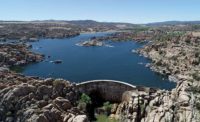The barge is the hub of operations. It is a miniaturized floating camp from which the 10- to 12-member crew supports the divers. "The people who do the real work are the diving supervisors, the guys on the barge and the 'sat' divers," says Rick Heaslet, project manager for Global Diving & Salvage.
A pair of teams comprises two divers trained not only as divers but also as construction personnel. Each team works a 10-hour shift, with one diver in the diving bell monitoring the other as he takes his five-hour turn at the work. Then, they switch places for another five hours until the bell is hauled to the surface and they are swapped out by the other team.
"Someone once told me that compared to a job you can do on the surface, any job you do underwater is three times harder," says Spencer Dell, a diver who recently completed a 30-day stint on the project.
The first task was demolition and removal of the remains of the failed vane and the vane next to it, which was intact. The concrete was sliced into 4-ft chunks by wire saws and hauled up by crane.
The new vanes consist of carbon-steel forms coated with corrosion protection that will be filled with non-aggregate concrete grout. The forms are being assembled by SRP. Global Diving & Salvage currently is working on anchoring and support preparations. Construction is expected to be complete by mid-August.






Post a comment to this article
Report Abusive Comment